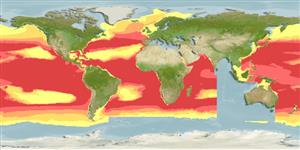>
Lophiiformes (Anglerfishes) >
Ceratiidae (Warty Seadevils)
Etymology: Ceratias: Greek, keras = horn or horned, refers to the lure projecting from the snout (Ref. 86949).
Environment: milieu / climate zone / depth range / distribution range
Ecología
marino batipelágico; rango de profundidad 0 - 2091 m (Ref. 26165), usually 500 - 1000 m (Ref. 58302). Deep-water
Circumglobal: In tropical waters. Western to eastern Central Atlantic. Deep sea (Ref. 4494). Reported from Indian and Pacific oceans (Ref. 58302).
Tamaño / Peso / Age
Maturity: Lm ? range ? - ? cm
Max length : 24.0 cm SL macho / no sexado; (Ref. 4494)
Characterized by female having simple esca, without distal escal appendages, illicium length 14.0 to 28.8% SL, invariably absent vomerine teeth; escal bulb usually darkly pigmented except distal tip, distal portion oval shaped, proximal portion tapering into stem of illicium; bulb without elevation of small pigment spot surrounding escal pore (Ref. 086949).
Also mesopelagic (Ref. 4494).
Life cycle and mating behavior
Madurez | Reproducción | Puesta | Huevos | Fecundidad | Larva
Bertelsen, E., 1990. Ceratiidae. p. 510-512. In J.C. Quero, J.C. Hureau, C. Karrer, A. Post and L. Saldanha (eds.) Check-list of the fishes of the eastern tropical Atlantic (CLOFETA). JNICT, Lisbon; SEI, Paris; and UNESCO, Paris. Vol. 1. (Ref. 4494)
IUCN Red List Status (Ref. 130435)
Threat to humans
Harmless
Human uses
Más información
Nombres comunesSinónimosMetabolismoDespredadoresEcotoxicologíaReproducciónMadurezPuestaAgregación para la puestaFecundidadHuevosEgg development
ReferenciasAcuiculturaPerfil de acuiculturaRazasGenéticaElectrophoresesheritabilidadEnfermedadesProcesamientoNutrientsMass conversion
ColaboradoresImágenesStamps, Coins Misc.SonidosCiguateraVelocidadTipo de nataciónSuperficie branquialOtolitosCerebrosVisión
Herramientas
Special reports
Download XML
Fuentes de Internet
Estimates based on models
Preferred temperature (Ref.
123201): 4.2 - 11.4, mean 6.6 °C (based on 1170 cells).
Phylogenetic diversity index (Ref.
82804): PD
50 = 0.6875 [Uniqueness, from 0.5 = low to 2.0 = high].
Bayesian length-weight: a=0.01000 (0.00244 - 0.04107), b=3.04 (2.81 - 3.27), in cm total length, based on all LWR estimates for this body shape (Ref.
93245).
Nivel trófico (Ref.
69278): 3.3 ±0.41 se; based on food items.
Fishing Vulnerability (Ref.
59153): Low vulnerability (19 of 100).
